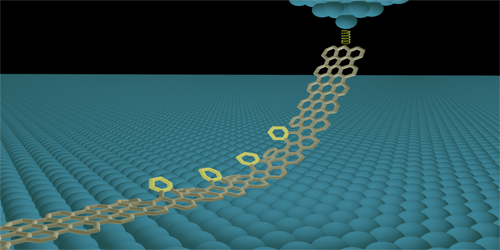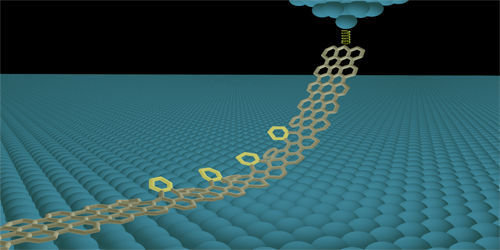How Defects Alter Graphene Nanoribbons
Nanotransistors, nanosensors, and medical nanorobots are just a few of the futuristic devices that will require electrical wires engineered to molecular precision. Graphene nanoribbons are a leading candidate to take on that role. These narrow strips of graphene, with widths of less than 50 nm, inherit all the electromechanical advantages of graphene but also have a tunable band gap that is crucial to many applications. However, no one has yet studied how inevitable molecular defects will impact their performance. Now, Matthias Koch at the Fritz Haber Institute of the Max Planck Society, Germany, and colleagues show that defects increase the flexibility of graphene nanoribbons while leaving their electronic properties unaffected.
Using a combination of scanning tunneling microscope and atomic force microscope techniques, the team identified defects in individual nanoribbons lying on a substrate. The defects appear as missing links in the graphene’s honeycomb structure and result in hexagonal cells that slightly protrude from the surface of the nanoribbon. Comparing ribbons with varying numbers of defects, the team then assessed how such defects affected the properties of the ribbons.
To test the ribbons’ mechanical properties, the researchers pulled them away from the substrate and measured the forces acting on the ribbons during the separation process. They also characterized the electrical properties of free-standing ribbons. Nanoribbons with more defects were found to be more flexible. However, the number of defects barely affected the ribbons’ electrical conductance. Koch and collaborators propose that by tuning the ribbons’ flexibility through the number of defects, nanodevice engineers could have flexible wires with exceptional conductance at their disposal.
This research is published in Physical Review Letters.
–Christopher Crockett
Christopher Crockett is a freelance writer based in Arlington, Virginia.





